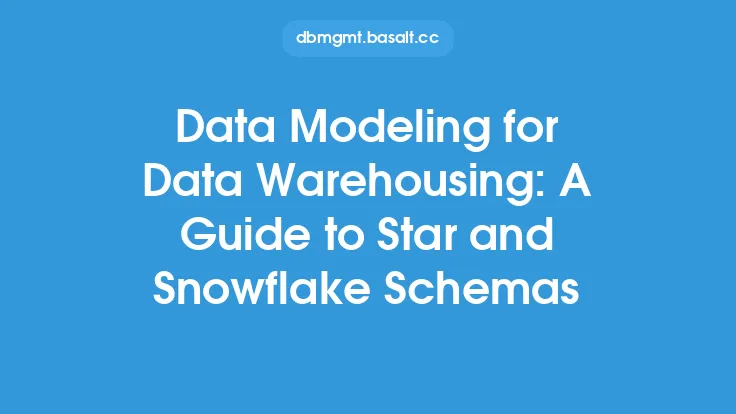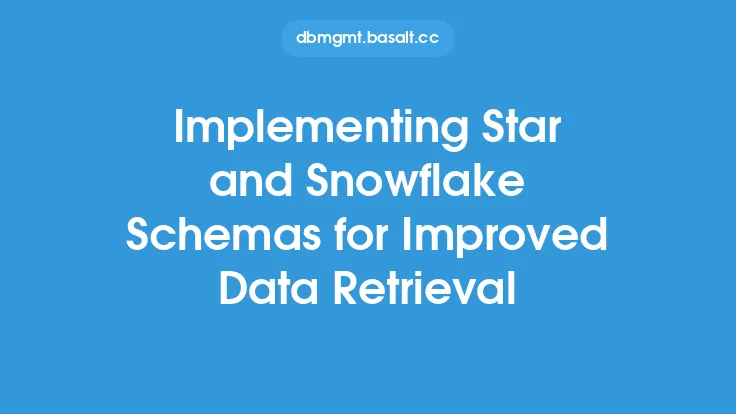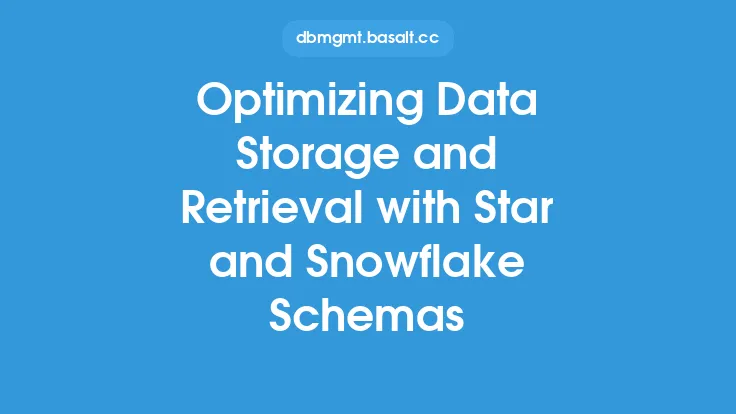Data warehousing is a crucial aspect of business intelligence, as it enables organizations to store, manage, and analyze large amounts of data from various sources. To design an efficient data warehouse, it's essential to choose the right data modeling technique. Two popular techniques used in data warehousing are Star and Snowflake schema. These techniques are used to optimize data storage, improve query performance, and enhance data analysis.
Introduction to Star Schema
The Star schema is a data modeling technique that consists of a central fact table surrounded by dimension tables. The fact table contains measurable data, such as sales or revenue, while the dimension tables contain descriptive data, such as date, customer, or product. The Star schema is called "star" because the dimension tables are connected to the fact table like the points of a star. This technique is widely used in data warehousing because it provides a simple and efficient way to store and query data.
Introduction to Snowflake Schema
The Snowflake schema is an extension of the Star schema, where each dimension table is further normalized into multiple related tables. This technique is called "snowflake" because the dimension tables are connected to each other like the intricate patterns of a snowflake. The Snowflake schema is used when there are multiple levels of granularity in the dimension data, and it provides a more detailed and normalized view of the data.
Key Differences Between Star and Snowflake Schema
The main difference between Star and Snowflake schema is the level of normalization. Star schema uses a denormalized approach, where each dimension table contains all the relevant data, while Snowflake schema uses a normalized approach, where each dimension table is broken down into multiple related tables. Another difference is the complexity of the schema, where Star schema is simpler and easier to maintain, while Snowflake schema is more complex and requires more maintenance.
Advantages of Star Schema
The Star schema has several advantages, including improved query performance, simplified data maintenance, and enhanced data analysis. The Star schema is optimized for query performance because it reduces the number of joins required to retrieve data. It also simplifies data maintenance because it reduces the number of tables that need to be updated. Additionally, the Star schema provides a simple and intuitive way to analyze data, making it easier to identify trends and patterns.
Advantages of Snowflake Schema
The Snowflake schema also has several advantages, including improved data normalization, reduced data redundancy, and enhanced data flexibility. The Snowflake schema provides a more normalized view of the data, which reduces data redundancy and improves data integrity. It also provides a more flexible way to store and query data, making it easier to adapt to changing business requirements.
Designing a Star Schema
To design a Star schema, you need to identify the fact table and the dimension tables. The fact table should contain measurable data, while the dimension tables should contain descriptive data. You should also identify the relationships between the fact table and the dimension tables, and ensure that each dimension table is connected to the fact table. Additionally, you should consider the level of granularity required for each dimension table, and ensure that the schema is optimized for query performance.
Designing a Snowflake Schema
To design a Snowflake schema, you need to identify the fact table and the dimension tables, and then further normalize each dimension table into multiple related tables. You should identify the relationships between each dimension table and the fact table, and ensure that each dimension table is connected to the fact table. You should also consider the level of granularity required for each dimension table, and ensure that the schema is optimized for query performance.
Best Practices for Implementing Star and Snowflake Schema
To implement Star and Snowflake schema effectively, you should follow several best practices. First, you should ensure that the schema is optimized for query performance, by reducing the number of joins required to retrieve data. Second, you should ensure that the schema is normalized, to reduce data redundancy and improve data integrity. Third, you should consider the level of granularity required for each dimension table, and ensure that the schema is flexible enough to adapt to changing business requirements. Finally, you should ensure that the schema is well-documented and easy to maintain, to reduce the risk of errors and improve data quality.
Common Challenges and Solutions
One common challenge when implementing Star and Snowflake schema is data redundancy, which can occur when there are multiple copies of the same data. To solve this problem, you can use data normalization techniques, such as eliminating redundant data and using surrogate keys. Another common challenge is query performance, which can be improved by optimizing the schema for query performance, using techniques such as indexing and caching. Additionally, you can use data aggregation techniques, such as rollup and drill-down, to improve query performance and enhance data analysis.
Conclusion
In conclusion, Star and Snowflake schema are two popular data modeling techniques used in data warehousing. The Star schema is a simple and efficient way to store and query data, while the Snowflake schema provides a more detailed and normalized view of the data. By understanding the advantages and disadvantages of each technique, and following best practices for implementation, you can design an efficient and effective data warehouse that meets your business requirements. Additionally, by being aware of common challenges and solutions, you can ensure that your data warehouse is optimized for query performance, data quality, and business intelligence.





